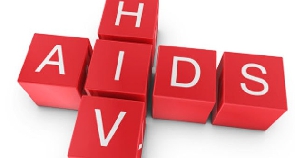A total of 33,870 people in the country tested positive for HIV at the end of the third quarter of 2022 that is from January to September out of which 24,017 were female and 9,853 were male.
A total of 9,160 adult males and 693 male children; 23,294 adult females and 723 female children tested positive; Dr. Stephen Ayisi Addo, Programme Manager, National AIDS/STI Control Programme (NACP) has stated.
He explained that a total of 1,441,986 people were tested during the period and 33,870 representing 2.3 percent tested positive. The figure also revealed that 17,846 non-pregnant women and 5,448 pregnant women tested positive.
Dr Ayisi Addo stated at the pre-launch event of a pragmatic national campaign focusing on HIV Self-Test (HIVST) kits at the Ghana News Agency Tema Industrial News Hub Boardroom Dialogue Platform.
The HIV Self-Test Kits pack contains an instruction manual for use written in both English and Twi, a test device, a preservative, a developer vial, and a test stand. The instruction manual also has simply eleven steps to follow with graphic pictures to guide the individual to self-administer without the help of any other person.
Dr. Ayisi Addo demonstrated the use of the HIVST kits to the Ghana News Agency Tema Regional Team and invited them to champion the Advocacy for its use ahead of the national launch and campaign in the year ahead-2023.
The regional HIV-positive cases at the end of the third quarter indicate that: Greater Accra recorded 6,863 followed by the Ashanti with 6,735, the Eastern had 4,968; the Central recorded 2,572; Bono hit 2,182; Western 1,960; Volta 1,830; Bono East 1,697; and the Western North 1,260.
The rest were: Ahafo recorded 905; Northern recorded 733; Oti had 621; Upper East recorded 620; Upper West hit 507; Savannah recorded 273; and North East with the least cases of 144.
The data available to the Ghana News Agency Tema Regional Office indicate that in 2016 a total of 739,920 and 38,582 tested positive representing 5.2 percent; in 2017 896,042 people were tested out of which 43,200 representing 5.0 percent tested positive; and in 2018 a total of 1,226,299 people were tested out of which 53,779 representing 4.0 percent tested positive.
A total number of 1,397,379 were tested in 2019 out of which 53,996 representing 3.9 percent tested positive; while in 2020 the number tested was 1,322,446, and 39,318 representing 3.0 percent tested positive; in 2021, a total number of 1,403, 015 were tested and 38,906 representing 2.8 percent tested positive.
Dr. Ayisi Addo even though admitted that the figures were dropping, expressed concern that the rate was very slow, which called for enhanced advocacy to fast-track the drop.
He called for attitudinal change as HIV is still prevalent, “people need to change their way of life for us to reduce the number drastically…am afraid the figures would hit over 40,000 by the time we collate the figures for the fourth quarter of 2022”.
Health News of Monday, 2 January 2023
Source: GNA

















